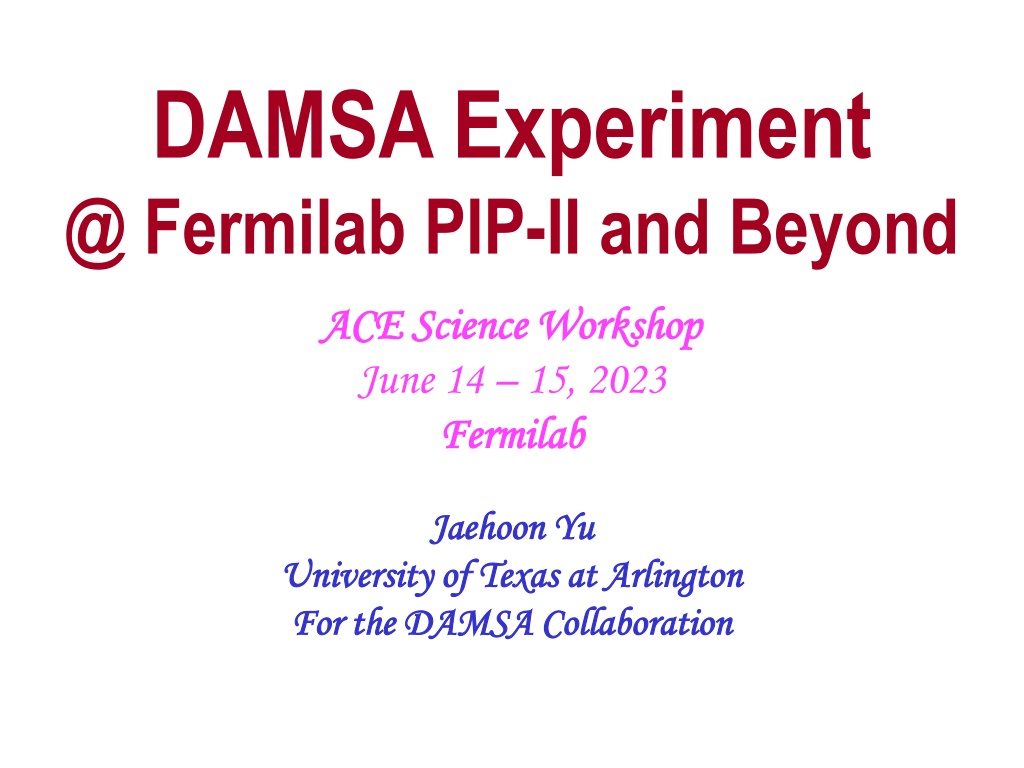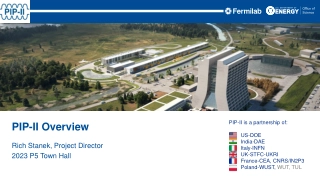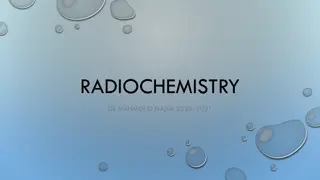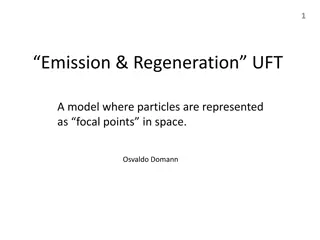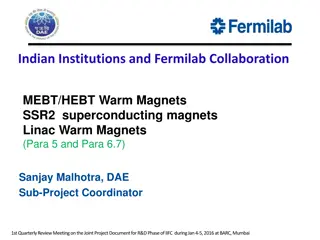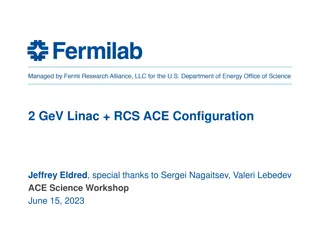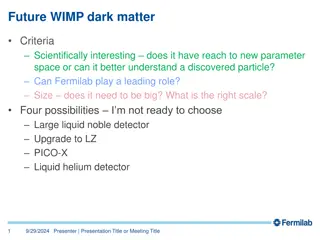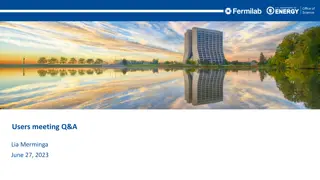Exploring Dark Sector Particles at Fermilab PIP-II and Beyond
The DAMSA experiment at Fermilab PIP-II aims to search for Dark Sector Particles (DSP) using a high-intensity proton beam facility. By focusing on Axion-like particles and employing specific physics strategies, DAMSA seeks to penetrate the low mass regime and discover rare particles in unexplored kinematic regions within an accelerator setup. The experiment targets building human infrastructure for Dark Matter production and expanding the exploration of the universe's dark matter component.
Download Presentation

Please find below an Image/Link to download the presentation.
The content on the website is provided AS IS for your information and personal use only. It may not be sold, licensed, or shared on other websites without obtaining consent from the author. Download presentation by click this link. If you encounter any issues during the download, it is possible that the publisher has removed the file from their server.
E N D
Presentation Transcript
DAMSA Experiment @ Fermilab PIP-II and Beyond ACE Science Workshop ACE Science Workshop June 14 15, 2023 Fermilab Fermilab Jaehoon Jaehoon Yu Yu University of Texas at Arlington University of Texas at Arlington For the DAMSA Collaboration For the DAMSA Collaboration
What is DAMSA? Dark sector particle (DSP) search and discovery experiment at low E, high intensity proton beam facility Stands for Dump produced Aboriginal Matter Search at an Accelerator (DAMSA) ( ) = Rumination or Reflection Jang et al., PRD 107, L031901 (2023) Aims to discover DSP s in the low mass regime at an accelerator ideally Ebeam below the pion threshold Originally developed for 600MeV proton beams at a nuclear rare isotope facility The 800MeV PIP-II and the ACE beams fit the bill The goal is to build the experiment by 2029 in time for PIP-II June 15, 2023 ASW - DAMSA @ PIP-II and ACE 2
Physics Motivation For DSP The SM describes the visible ~5% of the matter in the universe becoming more solidly established, while the neutrinos sector requires modifications Dark matter (Dark Sector Particle, DSP) makes up about 25% of the universe must be explored better Direct searches have limitations in kinematic reach, leaving low mass range un-explored Strategy: Search for rare particles in unexplored kinematic regime Make and discover DSPs in an accelerator Establish human infra on DM production Focus Future: SuperCDMS SNOLAB here Solar Neutrino Background 3 June 15, 2023 ASW - DAMSA @ PIP-II and ACE See Gordon K s talk
DAMSA Physics Strategy Focus on Axion-like particles (ALP) in their two-photon final state via the Primakoff process as the use case Produce as many photons as possible in the beam source, namely the dump Capture as many ALPs as possible in as wide a mass range as possible Shorten the distance from the source to the detector Increase the detector angular coverage Minimize the backgrounds from neutral particles Neutron spallation n QE, RES, and NC interactions Brdar, Yu et al., PRL126, 201801 (2021) June 15, 2023 ASW - DAMSA @ PIP-II and ACE 4
DAMSA Exp. Concept Inject and absorb as many low-E (1GeV or less) protons and produce as large number of g in the dump as possible Allow higher mass ALP s to decay with as small a number of neutrons escaping the dump as possible Place the detector as close to the dump as possible on axis to expand the mass reach to higher mass region Detector Vacuum Decay Volume L=10m W Dump Absorber L=1m Proton beam June 15, 2023 ASW - DAMSA @ PIP-II and ACE 5
DAMSA Sensitivity Reach Short lived! Capture decay products b4 det. Long lived! Capture decays in the detector June 15, 2023 6
DAMSA Experiment Strategy Overarching strategic goal: Get the detector ready to take data in time for PIP-II LINAC completion in 2029 Design and build the detector to meet the requirements with minimal R&D Fast timing (~0.1ns or better) High position resolution (~0.1mm or better) Excellent energy and invariant mass resolution Low threshold energy Discover Dark Sector Particles in the beam and produce the beam of them DAMSA June 15, 2023 ASW - DAMSA @ PIP-II and ACE 7
Conclusions DAMSA is a DSP search and discovery experiment that leverages high intensity, low energy proton beams ALP and other physics topics will be explored Detailed GEANT based studies performed for detector parameter requirements Optimization in progress Neutron background consideration DAMSA collaboration building (6 US, 5 SK, 1 EU)w/ the goal to submit a proposal to Fermilab PAC Jan. 2024 DAMSA presents an excellent opportunity for transforming Fermilab s PIP-II and ACE to a world-class DSP facility & to train the next generation physicists to lead dark matters in accelerators June 15, 2023 ASW - DAMSA @ PIP-II and ACE 8
Back Up Slides June 15, 2023 ASW - DAMSA @ PIP-II and ACE 9
Physics Motivation For DSP SM describes the visible ~5% of the matter in the universe becoming more solidly established, while the neutrinos sector requires modifications Dark matter (Dark Sector Particle, DSP) makes up about 25% of the universe must be explored better Direct searches have limitations in kinematic reach, leaving low mass range un-explored Strategy: Search for rare particles in unexplored kinematic regime Make and discover DSPs in accelerators Establish human infra on DM production Focus here 10 June 15, 2023 ASW - DAMSA @ PIP-II and ACE
DSPs? How do we make & see them? Set of new particles which do not experience the known forces DSPs can be weakly coupled to visible sector thru a mediator or portal High intensity proton beams produce large number of photons from brem, DY and neutral mesons decays Make it possible to contemplate couplings of new U(1) gauge to SM g Detection through an electron scattering, N(n) recoil or 1, 2 g final states June 5, 2023 PDSD - DAMSA @ PIP-II 11
Whats needed to discover a DSP? Direct Observation Signatures Requires high beam flux Large mass, high density detector for scattering Large volume, low density detector for decay Inferred Observation Signatures from both beam and cosmogenic sources Leverage oscillatory behaviors Large mass detectors for interactions What do we need to know? Signal flux and realistic behaviors in the detector Neutrino flux and their interactions in the detector as bck June 5, 2023 PDSD - DAMSA @ PIP-II 12
DAMSA Requirements The Beam PIP-II LINAC s 800MeV beam energy enables access to the tangible ALP mass range Need to have as much beam as possible ~1x1023 POT/yr was assumed in the PRD 600MeV physics study ~1x1023 POT/yr for PIP-II 800MeV and 1GeV physics study PIP-II CW beam characteristics (total proton current: 2mA) Bunch length: 1ns Np/bunch : 8x107 p/bunch Bunch spacing: 6.2ns PIP-II CW Chopping possibility? micro-pulses w/ two 14x107 p-bunches separated by 6.2ns and the next pair separated by 16.2ns, repeating every 22.4ns Each micro-pulse lasts for 0.6ms spaced every 50ms I=2mA/micro-pulse June 5, 2023 PDSD - DAMSA @ PIP-II 13
DAMSA Requirements The Dump What material on what depth would be most optimal? Produce most photons per unit length Produce least number of neutrons out the dump Absorb most particles per unit length GEANT4 based study shows 1m diameter, 1m long cylindrical shape tungsten dump (~10 nuclear interaction lengths) produces most photons and absorb ~99.995% 600MeV protons Neutrons produce additional photons in the dump, providing additional source for ALP June 5, 2023 PDSD - DAMSA @ PIP-II 14
DAMSA Requirements The Detector 1 What detector capabilities are needed to Capture as many ALP s as possible in as wide a mass range as possible High mass ALP s have shorter lifetime Need to be able to capture two photons from the ALP decays upstream of the detector Low mass ALP s live longer Allow them to decay and interact in the detector and capture decay products upstream of the detector as much as possible Reject accidental backgrounds from neutron spallation in the detector Reduce the materials upstream of the detector for neutron to interact Place a large decay volume in vacuum to fill the gap between the dump and the detector Extends detecting volume Vacuum decay chamber w/ 0.6cm SS wall thickness assumed this may have to be thicker Allows high mass ALPs to decay giving clear vertices where the two final state photons originate from Neutron interactions confined to the decay chamber walls June 5, 2023 PDSD - DAMSA @ PIP-II 15
DAMSA Requirements The Detector 2 What are other possible ways to further reduce the background from neutron spallation? Aim to reduce by order >=1010 Leverage the speed of the neutrons Neutrons are 10 1000 times heavier than the ALPs, thus for the given momentum, the arrival time of the neutron induced photon accidentals would be slower than that of the ALP s Leverage the distance of the closest approach of the two photon traces Require the traceback of the overlapping two photon momentum sum to point the dump Invariant mass of the two photon momenta be within the interested mass range Arrival time difference between two photons A large number of neutrons have low kinetic energy Require the photon energy to be greater than 5 MeV (detector threshold ~1MeV) June 5, 2023 PDSD - DAMSA @ PIP-II 16
DAMSA Detector Characteristics Based on the concept studies using GEANT4 and neutron background rejection studies The detector must be Capable of measuring up to 500 MeV photons with a MeV or better mass resolution Fine granularity for superb shower position (1cm or better) and angular resolutions Fast timing capability, ideally at the sub-ns (100ps or better) level resolution June 5, 2023 PDSD - DAMSA @ PIP-II 17
Potential DAMSA Detector Technology A total absorption EM calorimeter Sufficient depth to absorb photons up to 500MeV Need further optimization for low mass ALP decays Crystal or plastic scintillation counter with fine lateral and longitudinal granularity (M~160t) A thin (<5cm) triangular pixels with a fast photon detector attached to the pixel Lateral and longitudinal granularity SPAD, MCP, Hybrid SiPM, etc A study to develop the most optimal detector for the physics has begun June 5, 2023 PDSD - DAMSA @ PIP-II 18
Potential DAMSA Experiment Timeline May Dec. 23 : Form a team and prepare a proposal to Fermilab PAC Physics goals and sensitivity reach Detector design and rough cost estimates Jan. 2024: Submit the DAMSA proposal to PAC 2024 2025/2026: experiment approval and project establishment 2025/2026 2028: experiment construction 2029: Complete the detector construction and start commissioning for data taking Internationality would be important Korean and European colleagues June 5, 2023 PDSD - DAMSA @ PIP-II 19
DAMSA Experiment Team DAMSA has been introduced to the community throughout the past 2 years, more intensely in 2023 Multiple presentations made at conferences and workshops The concept was included in a few Snowmass2021 white papers At the physics opportunities at PIP-II BD and beyond at Fermilab 5/10 5/13/23, the discussion on DAMSA experiment occurred 5/12 5/12/23 Introduced to Fermilab leadership April and May 2023 The team consists of Lead Investigators: Jae Yu and Juan Estrada (FNAL) Institutions expressed interests thus far: US (6+2): FNAL, OU, TAMU, UCR, UCI, U. of Kansas (TBC), LANL (TBC), UTA SK (5+3): SNU, Yeonsei U. (TBC), U. of Seoul, Chungnam U. (TBC), Jeonbuk U. (TBC), KNU-CHEP, Korea U., Korea U. - Chochiwon Campus Portugal: LIP (TBC) June 5, 2023 PDSD - DAMSA @ PIP-II 20
1st Workshop on Physics Opportunities at PIP-II May 10 May 13, 2023 Juan Estrada Matt Toups June 5, 2023 PDSD - DAMSA @ PIP-II 21
Parting Questions to this crowd What other physics can we do with the DAMSA experiment configuration? What modifications to DAMSA experimental configuration to dramatically expand the physics reach? What are the tools necessary for DAMSA physics reach in a timely manner? June 5, 2023 PDSD - DAMSA @ PIP-II 22
